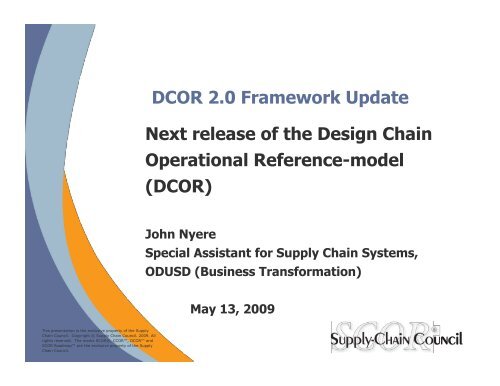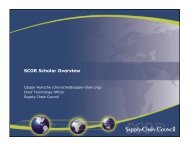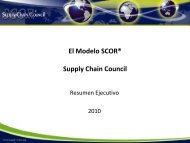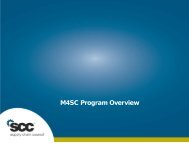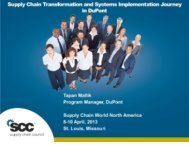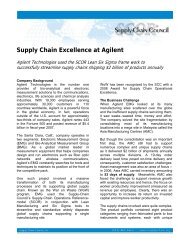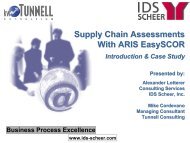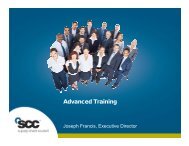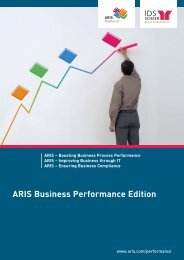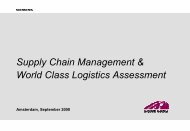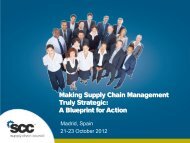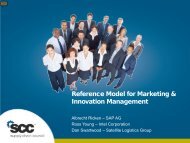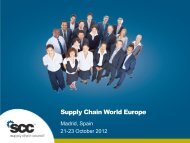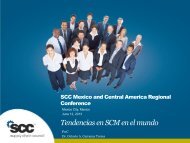Create successful ePaper yourself
Turn your PDF publications into a flip-book with our unique Google optimized e-Paper software.
<strong>DCOR</strong> 2.0 Framework UpdateNext release of the Design <strong>Chain</strong>Operational Reference-model(<strong>DCOR</strong>)John NyereSpecial Assistant for <strong>Supply</strong> <strong>Chain</strong> Systems,ODUSD (Business Transformation)May 13, 2009This presentation is the exclusive property of the <strong>Supply</strong><strong>Chain</strong> <strong>Council</strong>. Copyright © <strong>Supply</strong> <strong>Chain</strong> <strong>Council</strong>. 2009. Allrights reserved. The marks SCOR®, CCOR, <strong>DCOR</strong> andSCOR Roadmap are the exclusive property of the <strong>Supply</strong><strong>Chain</strong> <strong>Council</strong>.
Today’s Agenda• <strong>DCOR</strong> History• Teams• Macro Differences – last release and proposedrelease• Design <strong>Chain</strong> definition and importance• <strong>DCOR</strong> overview• Where it fits• Execution Elements• Amend• Planning• Enable• Metrics• Recap and QuestionsCopyright © <strong>Supply</strong> <strong>Chain</strong> <strong>Council</strong>, 2009. All rights reserved22
<strong>DCOR</strong> Update History• 2006 : SCC releases <strong>DCOR</strong> release 1.0.This includes best practices , revampedmetrics and a 3 rd Amend process- Specification Change.• Sep 2008 : started revision of <strong>DCOR</strong> release 2.0.Goal: Bring <strong>DCOR</strong> model to same level of maturity as SCOR• Proposed 2.0 at TDSC in October• Teams Reviewed and Revised• 16 April to 10 May – Cleanup and Publish “Preview”• “Preview” Release 13 May at Convergence Forum in Atlanta• Post 13 May - Review issues, complete consolidations• Formal approval and release, then package for publicationCopyright © <strong>Supply</strong> <strong>Chain</strong> <strong>Council</strong>, 2009. All rights reserved33
Teams• Research – HP• Design – PRTM, ValuePlus (Taiwan)• Integrate –Cisco• Amend – USAF, BearingPoint• Planning – SCC• Metrics – IBM China• Best Practices – PTC• Risk Management – IBM (D,Morrow)• Model Hosting/support - EiiSolutions• Lead - DoDCopyright © <strong>Supply</strong> <strong>Chain</strong> <strong>Council</strong>, 2009. All rights reserved44
<strong>DCOR</strong> 2.O Differences – the MacroSo what is new and different?1. Revised to conform to look and feel of SCOR 92. Seven new process elements – 5 Risk Management, 2 Integrate3. New Metric Trees from L1 to L34. More Metrics –<strong>DCOR</strong> 1.0 <strong>DCOR</strong> 2Cost * 117 219Responsiveness * 69 208Agility 10 345Asset Management 11 161Reliability 5 2015. Best Practices: 270 373 New and proposed6. Inputs/Outputs 115 495 SCOR 9 aligned7. Best Practice index8. KPI Indices* Aligned to refresh, new product and new technology –widely different cycle-times/risks/costsCopyright © <strong>Supply</strong> <strong>Chain</strong> <strong>Council</strong>, 2009. All rights reserved55
Design <strong>Chain</strong> Importance• When you are producing or repairing product in the supply chain,where do Specifications come from?• When you Engineer-To-Order products, or for that matter Maketo Stock or Order, where do BOMs, routings, work instructions,procedures, product documentation, etc come from?• Where does product data come from? What can I specify as adeliverable if I am a customer with various sustainmentstrategies?• When the product fails, where do you go to fix it.• When you are a customer, and put in your “requirements.” howand when do you know they are being achieved? e.g. reliability,cost, sustainment, maintainability, reliability, all the “DesignFor’s” …..• How do you revise an existing product, develop new productsand acquire new technology/materials/vendors?Copyright © <strong>Supply</strong> <strong>Chain</strong> <strong>Council</strong>, 2009. All rights reserved66
Design <strong>Chain</strong>• The collection of processes that translate ideas forproducts into product definitions –such as recipes,BOMs, work instructions, workflow– and develops or reusesthe processes and infrastructure for selling,fulfillment and support of the product.• Is where we:• refresh products,• design new products and procedures,• obtain new technologies/materials/sources• address non-conforming, fallout, deficient products and changeour specifications/requirements• manage our product development portfolio• Develop and maintain our product data over the product lifecycleCopyright © <strong>Supply</strong> <strong>Chain</strong> <strong>Council</strong>, 2009. All rights reserved77
Design <strong>Chain</strong>Product/Portfolio Management (PPM)Supplier processesProduct DesignSales & Support<strong>DCOR</strong>CCOR<strong>Supply</strong> <strong>Chain</strong>SCOR ®Customer processesCopyright © <strong>Supply</strong> <strong>Chain</strong> <strong>Council</strong>, 2009. All rights reserved88
Design <strong>Chain</strong> ProcessesDesign <strong>Supply</strong> <strong>Chain</strong> <strong>Chain</strong> Processes“Supplier” processesResearchPlanDesignIntegrate“Customer” processesAmendProcess, arrow indicates design materials flow directionProcess, no design materials flowInformation flowCopyright © <strong>Supply</strong> <strong>Chain</strong> <strong>Council</strong>, 2009. All rights reserved99
A designer and manufacturer of complex productsDesign <strong>Chain</strong> Processes<strong>Supply</strong> <strong>Chain</strong> ProcessesPlanPlanResearchDesignIntegrateSourceMakeDeliverCustomerAmendReturnVPNew ProductDevelopmentOperationsCopyright © <strong>Supply</strong> <strong>Chain</strong> <strong>Council</strong>, 2009. All rights reservedVPManufacturingVP ProductSustainment1010
End-to-End"Supplier" "Component" "Product"hard drive co.storageflash drive co.human interfacemp3 playerhard and flash co.mp3 technologyonline music storeinternal labs.web technologyresearchdesignintegrateresearchdesignintegrateresearchdesignintegrateCopyright © <strong>Supply</strong> <strong>Chain</strong> <strong>Council</strong>, 2009. All rights reserved1111
<strong>DCOR</strong>: Another Process Framework• Process frameworks integrate the well-knownconcepts of business process reengineering,benchmarking, and process measurement into across-functional framework• Standard processes:Plan, Research, Design, Integrate, Amend• Standard metrics:Perfect Design, Design <strong>Chain</strong> Cycle Time, Design <strong>Chain</strong> Cost, etc• Standard practicesCollaborative design, Stage gate reviews, etc• Pre-defined relationships between processes,metrics and practicesCopyright © <strong>Supply</strong> <strong>Chain</strong> <strong>Council</strong>, 2009. All rights reserved1212
<strong>DCOR</strong> HierarchyLevel 1 Level 2 Level 3 Level 4 Level 5Scope Configuration Activity Workflow TransactionsDesign <strong>Chain</strong>ResearchR1ResearchProduct RefreshR1.2Source MaterialsEDIXMLDifferentiatesBusinessDifferentiatesComplexityNames TasksSequencesStepsLinksTransactionsDefines ScopeDifferentiatesCapabilitiesLinks, Metrics,Tasks andPracticesJob DetailsDetails ofAutomationFrameworkLanguageFrameworkLanguageFrameworkLanguageIndustry orCompanySpecificLanguageTechnologySpecificLanguageStandard <strong>DCOR</strong> definitionsCopyright © <strong>Supply</strong> <strong>Chain</strong> <strong>Council</strong>, 2009. All rights reservedCompany/Industry definitions1313
Execution Processes• <strong>DCOR</strong> recognizes three mainstream execution processes:Research, Design and Integrate. These processes source,integrate and distribute product definitions, procedures andmethods, and rules throughout the companyPlanResearchDesignIntegrateAmendCopyright © <strong>Supply</strong> <strong>Chain</strong> <strong>Council</strong>, 2009. All rights reserved1414
Research (Level 1)• Objective:• Finding, testing and approving sources of materials, knowledge andtechnology for products or services. This includes collecting andarchiving specifications of parts, obtaining (new) manufacturing, deliveryand/or sales techniques, and identification and verification of (sub-)contractors.• Keywords:• Technology/knowledge/product trends• Supplier identification• Supplier and component verification• Documentation of form/fit/functionCopyright © <strong>Supply</strong> <strong>Chain</strong> <strong>Council</strong>, 2009. All rights reserved1515
Capability Models – Level 2Level: Different capabilities – need different measurementsProduct Refresh (R1, D1, I1)• Plan driven• Minor changes to the product• Short turn-around times (now discretely measured and costed)New Product (R2, D2, I2)• Market driven• Significant change in product (line)• Longer turn-around times (now discretely measured and costed)New Technology (R3, D3, I3)• Market and technology driven• Significant change to product andproduction processes• Strategic change, long lead-times (now discretely measured and costed)Copyright © <strong>Supply</strong> <strong>Chain</strong> <strong>Council</strong>, 2009. All rights reserved1616
Research (Level 3) – No ChangeProduct Refresh (R1) New Product (R2) New Technology (R3)R2.1 Receive andValidate RequestR3.1 Receive andValidate RequestR1.1 Schedule ResearchActivitiesR2.2 Schedule ResearchActivitiesR3.2 Identify Sources forTechnologyR3.3 Schedule ResearchActivitiesR1.2 Source Materials R2.3 Source Materials R3.4 Source Materials/TechnologyR3.5 EstablishVerification ProcessR1.3 Verify Materials R2.4 Verify Materials R3.6 Verify Materials/TechnologyR1.4 Transfer Findings/MaterialsR2.5 Transfer Findings/MaterialsR3.7 Transfer Findings/MaterialsR1.5 Authorize Supplier R2.6 Authorize SupplierPaymentPaymentCopyright © <strong>Supply</strong> <strong>Chain</strong> <strong>Council</strong>, 2009. All rights reservedR3.8 Authorize SupplierPayment17 1717
Design (Level 1)• Objectives:• Decomposition of the (new) product requirementsand design of the product or service. This includes developingand testing prototypes.• Keywords:• Prototypes ('laboratory' environment)• Technical drawings/Specifications• Form, fit and function• Product/service costing• Manufacturing process design• <strong>Supply</strong> chain process design• Service and support process designCopyright © <strong>Supply</strong> <strong>Chain</strong> <strong>Council</strong>, 2009. All rights reserved1818
Design (Level 2)• Design Product Refresh (D1)• Plan-driven scheduled update of an existing product or service.The existing product specifications are refreshed, no significantredesign activities.• Design New Product (D2)• The grounds-up or significant redesign of a product or service.The product or service is build on an existing technology• Design New Technology (D3)• Design new technology. This includes technology that is new toyour company. Technology includes techniques formanufacturing or services delivery.Copyright © <strong>Supply</strong> <strong>Chain</strong> <strong>Council</strong>, 2009. All rights reserved1919
Design (Level 3)Product Refresh (D1) New Product (D2) New Technology (D3)D1.1 Schedule DesignActivitiesD2.1 Receive Validate andDecomposeD2.2 Schedule DesignActivitiesD3.1 Receive Validate andDecomposeD3.2 Schedule DesignActivitiesD3.3 Acquire KnowledgeD1.2 Design andValidateD1.3 Build and TestPrototypeD2.3 Design andValidateD2.4 Build and TestPrototypeD3.4 Design andValidateD3.5 Build and TestPrototypeD1.4 Package Design D2.5 Package Design D3.6 Package DesignD1.5 Release Design to D2.6 Release Design toIntegrateIntegrateCopyright © <strong>Supply</strong> <strong>Chain</strong> <strong>Council</strong>, 2009. All rights reservedD3.7 Release Design toIntegrate2020
Integrate (Level 2)• Integrate Product Refresh (I1)• Replace an existing product. Examples: minor revision of a car (newmodel year), upgrade of standard specs of consumer products such asappliances, electronics and personal computers• Integrate New Product (I2)• The roll-out of a new product. Significant change in workflow,instructions, bills-of-materials/recipes. Normally not a significant changein production and/or test equipment.• Integrate New Technology (I3)• Launching new products which contain or require new technology. Asignificant change in production and testing equipment, training andchange in procedures.Copyright © <strong>Supply</strong> <strong>Chain</strong> <strong>Council</strong>, 2009. All rights reserved2222
Integrate (Level 3) – changesProduct Refresh (I1) New Product (I2) New Technology (I3)I1.1 Receive & ValidateRequestI2.1 Receive & ValidateRequestI3.1 Receive & ValidateRequestI1.2 Decompose Request I2.2 Decompose Request I3.2 Decompose RequestI1.3 Obtain & ValidateDesignI2.3 DistributeRequirementsI2.4 Receive & ValidateDesignI3.3 DistributeRequirementsI3.4 Receive & ValidateDesignI1.4 Establish ExecutionProcessesI2.5 Establish ExecutionProcessesI3.5 Establish ExecutionProcessesI1.5 Pilot Design I2.6 Pilot Design I3.6 Pilot DesignI1.6 Package Product I2.7 Package Product I3.7 Package ProductI1.7 Release Product I2.8 Release Product I3.8 Release ProductCopyright © <strong>Supply</strong> <strong>Chain</strong> <strong>Council</strong>, 2009. All rights reserved2323
Control processes: Plan, Enable• Enable plan and enable processes prepare the designchain to ensure smooth execution• Planning processes balance the need for resources,materials, lab availability, etc. and the availability of theseresources. This includes prioritization when needed.• Enable processes address 9 or 10 control aspects for thedesign chain. They monitor compliance, integrateinformation from other process areasand highlight dependencies on theseother process areasCopyright © <strong>Supply</strong> <strong>Chain</strong> <strong>Council</strong>, 2009. All rights reserved2424
Plan Process Elements – New NamesPlan Design <strong>Chain</strong>(PP)Plan Research (PR)Plan Design (PD)Plan Integrate (PI)Plan Amend (PA)PP.1 Gather Design<strong>Chain</strong>RequirementsPR.1 GatherResearchRequirementsP3.1 GatherDesignRequirementsPI.1 GatherIntegrateRequirementsPA.1 GatherAmendRequirementsPP.2 GatherDesign <strong>Chain</strong>ResourcesPR.2 GatherResearchResourcesP3.2 GatherDesignResourcesPI.2 GatherIntegrateResourcesPA.2 GatherAmendResourcesPP.3 BalanceResources withDesign <strong>Chain</strong>RequirementsPR.3 BalanceResources withResearchRequirementsP3.3 BalanceResources withDesignRequirementsPI.3 BalanceResources withIntegrationRequirementsPA.3 BalanceResources withAmendRequirementsPP.4 EstablishDesign <strong>Chain</strong>PlanPR.4 EstablishResearchPlanP3.4 EstablishDesignPlanPI.4 EstablishIntegrationPlanPA.4 EstablishAmendPlanCopyright © <strong>Supply</strong> <strong>Chain</strong> <strong>Council</strong>, 2009. All rights reserved2525
Enable Processes• Objective:The Enable processes are five groups of processes under Plan,Research, Design, Integrate and Amend with 3 distinct types ofobjectives:1. Manage process performance2. Manage process control data5. Manage process relationships• Key processes comprehended:• Managing business rules and monitoring adherence• Measuring design chain performance and determine corrective action• Managing supplier and service provider relationships• Managing the design chain network and facilities• Hint: Documentation management? Probably EnableCopyright © <strong>Supply</strong> <strong>Chain</strong> <strong>Council</strong>, 2009. All rights reserved2626
Enable Process ElementsPlanResearchDesignIntegrateAmendManage Business Rules EP.1 ER.1 ED.1 EI.1 EA.1Manage Process Performance EP.2 ER.2 ED.2 EI.2 EA.2Manage Process Information EP.3 ER.3 ED.3 EI.3 EA.3Manage Product Life Cycle EP.4 ER.4 ED.4 EI.4 EA.4Manage Design-<strong>Chain</strong> Capital Assets EP.5 ER.5 ED.5 EI.5 EA.5Manage Knowledge Transfer EP.6 ER.6 ED.6 EI.6 EA.6Manage Process Network EP.7 ER.7 ED.7 EI.7 EA.7Manage Process Regulatory Compliance EP.8 ER.8 ED.8 EI.8 EA.8Manage Risk EP.9 ER.9 ED.9 EI.9 EA.9Manage Financial Plan AlignmentManage Intellectual PropertyCopyright © <strong>Supply</strong> <strong>Chain</strong> <strong>Council</strong>, 2009. All rights reservedEP.10ED.102727
Reverse Flow: Amend• Objective of this process:• Resolving design issues and supporting design adaptations.• Example Amend Types:• Product cannot be manufactured or fulfilled (A1)• Vendor disappeared (earthquake, bankruptcy)• Component availability (single vs. dual sourcing)• Dimensions not supported (too heavy, too tall)• Product does not perform according to specifications (A2)• Product 'quality' issues• Repair volume increased observed• Recalls result from the Amend process• Product specification changes to support orders• Engineer-to-order orders (e.g. planes, trucks)• Pharma, CPG, Systems Engineering (change to Requirement)Copyright © <strong>Supply</strong> <strong>Chain</strong> <strong>Council</strong>, 2009. All rights reserved2828
Amend Process ElementsProduct Fall Out (A1) Deficient Product (A2) Product Specs (A3)A1.1 Receive & ValidateIssue (ECR)A2.1 Obtain DeficiencyInformation (ECR)A2.1 Obtain SpecificationInformation*A2.2 Validate Issue A2.2 Validate IssueA1.2 Decompose Issue (ECN) A2.3 Decompose Issue (ECN) A2.3 Decompose Issue (SCN)A1.3 Distribute Issue & ECO A2.4 Distribute Issue & ECO A2.4 Distribute Issue & SCOA1.4 Publish Advisory (ECN) A2.5 Publish Advisory (ECN) A2.5 Publish Advisory (SCN)* Could be an SCR, ECP, ECR, or other trigger…Copyright © <strong>Supply</strong> <strong>Chain</strong> <strong>Council</strong>, 2009. All rights reserved2929
Performance AttributesAttributeReliabilityResponsivenessAgilityCostStrategyConsistently getting the right product AND processdesign, meeting quality requirements and on-timecompletion of integrationThe consistent speed of designing and integratingnew products/servicesThe ability to respond to unplanned events(incl. external influences and quality issues)The cost associated with managing and operatingthe design chainAssetsCopyright © <strong>Supply</strong> <strong>Chain</strong> <strong>Council</strong>, 2009. All rights reservedThe effectiveness in managing the design chain’sassets in support of design and integration of newproductsQuestion: What are the most important attributes for your design chain?3030
<strong>DCOR</strong> KPIs; Strategic MetricsAttributeReliabilityResponsivenessAgilityCostAssetsStrategic MetricPerfect Product DesignDesign <strong>Chain</strong> Cycle TimeProduct Design <strong>Chain</strong> Change Cycle TimeTotal Design <strong>Chain</strong> Cost or Cost of Goods in DesignDesign <strong>Chain</strong> Fixed Assets ValueCopyright © <strong>Supply</strong> <strong>Chain</strong> <strong>Council</strong>, 2009. All rights reserved3131
<strong>DCOR</strong> Performance AttributesPerformance Attribute: a characteristic to describe a strategy. Thefollowing metric trees are in the model.<strong>DCOR</strong> Performance AttributesDesign <strong>Chain</strong> AgilityAG.1.1 Upside Design <strong>Chain</strong> FlexibilityAG.1.2 Upside Design <strong>Chain</strong> AdaptabilityAG.1.3 Downside Design <strong>Chain</strong> AdaptabilityAG.1.4. Product Design Change Cycle TimeDesign <strong>Chain</strong> Asset ManagementAM.1.1 Design <strong>Chain</strong> Fixed Assets ValueAM.1.2 Return on Design <strong>Chain</strong> Fixed AssetsAM.1.3 Return on Working CapitalDesign <strong>Chain</strong> CostsCO.1.1 Total Design <strong>Chain</strong> Management CostsCO.1.2 Cost of Goods in DesignDesign <strong>Chain</strong> ReliabilityRL.1.1 Perfect Product DesignDesign <strong>Chain</strong> ResponsivenessRS.1.1 Design <strong>Chain</strong> Cycle TimeCopyright © <strong>Supply</strong> <strong>Chain</strong> <strong>Council</strong>, 2009. All rights reserved323832
Strategic Cost MetricMetric: Total Design <strong>Chain</strong> CostDefinition: The costs associated with operating the design chain.Calculation: Sum of the cost to plan, research, design, integrate andL2 Metrics:(sample)amend. These are all costs associated with managing thedesign chain. (People, facilities, materials, etc.)• Plan Cost• Research cost• Design cost• Integrate cost• Amend costNotes: Compare: R&D Cost on the 10-K for public companiesWill probably go away as its corollary in the <strong>Supply</strong> <strong>Chain</strong>(Total <strong>Supply</strong> <strong>Chain</strong> Management Cost)Copyright © <strong>Supply</strong> <strong>Chain</strong> <strong>Council</strong>, 2009. All rights reserved3333
Or Strategic Cost MetricMetric: Cost of Goods in DesignDefinition: The costs associated with products in DesignA corollary to COGS.Calculation: The value of the R&D Portfolio of products inL2 Metrics:(sample)development. Hence the calculation would be:Portfolio value (cost of new products in development) atbeginning of the year/period +net purchases +cost of labor+materials and supplies+ other costs - value of productslaunched at the end of the year/period= Cost of Goods in Design• Plan Cost• Research cost• Design cost• Integrate cost• Amend costNotes: Compare: R&D Cost on the 10-K for public companiesCopyright © <strong>Supply</strong> <strong>Chain</strong> <strong>Council</strong>, 2009. All rights reserved3434
Strategic Reliability MetricMetric: Perfect Product DesignDefinition: The ability of the design chain to deliver product designswhich meet the following standards: on-time, right product,complete documentation, supply-chain ready, product testingand certification completeCalculation: [Total perfect designs]/[Total designs] x 100%L2 Metrics:(sample)Perfect design = on-time request * certifications complete *documentation complete * manufacturing readiness and riskassessment complete * more..• % On-time to commit• # of design errors• Documentation complete• Perfect IntegrationNotes: Perfect design is the product of lower level metricsFor each design the value is either 0 or 100%Copyright © <strong>Supply</strong> <strong>Chain</strong> <strong>Council</strong>, 2009. All rights reserved3535
Strategic Responsiveness MetricMetric: Design <strong>Chain</strong> Cycle TimeDefinition: The average speed at which a design chain generatesproduct designs.Calculation: [Sum of actual cycle times for all completed designs]/L2 Metrics:(sample)[Total number of completed designs]Actual cycle time = time between receipt of designrequirements and release of the product design to operations• Research cycle time• Design cycle time• Integrate cycle timeNotes: Consider the cycle time targets fordifferent products and differenttechnology life cycle phasesCopyright © <strong>Supply</strong> <strong>Chain</strong> <strong>Council</strong>, 2009. All rights reserved3636
Strategic Agility MetricMetric: Product Design Change Cycle TimeDefinition: Time to change a product design after it has been released tooperations.Calculation: [Sum of Amend cycle times]/[Total number of events]Amend cycle time = time between receipt of ECOrequirements and release of the revised design to operationsL2 Metrics:(sample)• Pilot build time• Amend cycle time• Re-plan frequencyNotes: Typical scenarios:RECALL• Supplier bankruptcy• Product recallsThe product has previously been released to operationsCopyright © <strong>Supply</strong> <strong>Chain</strong> <strong>Council</strong>, 2009. All rights reserved3737
Strategic Asset MetricMetric: Design <strong>Chain</strong> Fixed Assets ValueDefinition: The total value of all design chain assetsCalculation: Sum of Plan, Research, Design, Integrate and Amend fixedL2 Metrics:(sample)asset values• Plan Fixed Assets Value• Research Fixed Assets Value• Design Fixed Assets Value• Research Fixed Assets Value• Integrate Fixed Assets Value• Amend Fixed Assets ValueNotes: Check Ex.5 Manage Fixed Asset processesCopyright © <strong>Supply</strong> <strong>Chain</strong> <strong>Council</strong>, 2009. All rights reserved3838
Recap: <strong>DCOR</strong> Background• Originally developed by Hewlett-Packard• Adopted by <strong>Supply</strong>-<strong>Chain</strong> <strong>Council</strong>• First SCC release refined or added metrics, best practices andA3 Amend product specifications process• <strong>DCOR</strong> is founded on the SCOR framework architecture:• Input, process, output, planning and control• 3 pre-defined levels• Integrated metrics, processes and best practicesCopyright © <strong>Supply</strong> <strong>Chain</strong> <strong>Council</strong>, 2009. All rights reserved3939
Recap: Process Framework• Process Framework components and benefits:• Processes defined• Metrics defined• Best practices identified• And relationships between these pre-defined• What it is not:• A pre-defined map of your company• A must-have list of metrics• A must-have list of practicesCopyright © <strong>Supply</strong> <strong>Chain</strong> <strong>Council</strong>, 2009. All rights reserved4040
Recap: Key <strong>DCOR</strong> Processes• Planning and control processes:• Plan Design <strong>Chain</strong>; Drive overall plan and budget• Plan Research, Plan Design, Plan Integrate, Plan Amend• Enable; Align resources and monitor performance• Execution processes:• Research; Collecting knowledge and parts• Design; Technical engineering and documentation• Integrate; Prepare and release to operations• Reverse processes:• Amend; Correct research, design or integration flaws andaddressed changes to orders/requirements/specsCopyright © <strong>Supply</strong> <strong>Chain</strong> <strong>Council</strong>, 2009. All rights reserved4141
Recap: Process Configuration• Categories:• Product Refresh; Existing products, small change• New product; Existing technology, change to product• New Technology; New processes, significant change• Behaviors:• Life Cycle status of product determines which category• Different categories are measured differently• New technology products is partially new product andpartially product refresh• New product is partially product refreshCopyright © <strong>Supply</strong> <strong>Chain</strong> <strong>Council</strong>, 2009. All rights reserved4242
Recap: Key <strong>DCOR</strong> Metrics• Metric Types• Reliability; Perfect Product Design• Responsiveness; Design <strong>Chain</strong> Cycle Time• Flexibility; Product Design Change Cycle Time• Cost; Total Design <strong>Chain</strong> Cost• Assets; Total Design <strong>Chain</strong> Fixed asset Value• Metrics and levels;• Set the scope using level 1 (strategic) metrics• Drill down to the root cause• Different process configurations make differentmeasurementsCopyright © <strong>Supply</strong> <strong>Chain</strong> <strong>Council</strong>, 2009. All rights reserved4343
Model Is Available For Review• http://scc-aris.eiisolutions.net:8080/businesspublisher/• Userid: GuestPassword: <strong>DCOR</strong>4UCopyright © <strong>Supply</strong> <strong>Chain</strong> <strong>Council</strong>, 2009. All rights reserved4444
• www.supply-chain.org• www.scorlabs.orgFor follow-up questions about the <strong>DCOR</strong> Model or the<strong>Supply</strong> <strong>Chain</strong> <strong>Council</strong> and its Products or Services:jfrancis@supply-chain.orgFor follow-up questions specific to the content anddiscussions of this Workshop:John.Nyere@osd.mil703 693 1685This presentation is the exclusive property of the <strong>Supply</strong><strong>Chain</strong> <strong>Council</strong>. Copyright © <strong>Supply</strong> <strong>Chain</strong> <strong>Council</strong>. 2009. Allrights reserved. The marks SCOR®, CCOR, <strong>DCOR</strong> andSCOR Roadmap are the exclusive property of the <strong>Supply</strong><strong>Chain</strong> <strong>Council</strong>.Copyright © <strong>Supply</strong> <strong>Chain</strong> <strong>Council</strong>, 2009. All rights reserved454545


